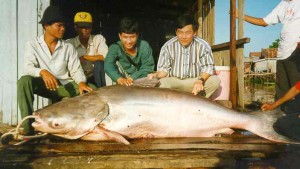
The Mekong giant catfish Pangasianodon gigas is one of the world’s largest freshwater fish and a charismatic animal revered throughout the lower Mekong. Its capture in fisheries is very rare, and invariably attracts great attention in the local and regional media. For this reason and the fact that its life history (long-lived, late-maturing and long-distance migrant) makes the species vulnerable to human disturbances from fishing to dam building, it is widely seen as a ‘flagship species‘ for conservation of the lower Mekong ecosystem its fisheries.
Mekong Giant Catfish Working Group (MGCWG) was set up in 2005 to coordinate and evaluate conservation initiatives and develop an overarching conservation strategy. The MGCWG brought together the major relevant organizations including the MRC Fisheries Program, Mekong Wetlands Biodiversity Program, Cambodian Fisheries Administration, Lao Department of Livestock and Fisheries, Thai Department of Fisheries, Network of Aquaculture Centers in Asia-Pacific, Kasetsart University, WWF, IUCN, and Imperial College London. The conservation strategy was developed through a series of workshops, combined with focused research to assess the status of the wild and captive populations and the likely effectiveness of management options. The conservation strategy was completed in 2007.
Publications:
MGCWG Report 1: Inception & Planning Meeting (Bangkok 2005) PDF
MGCWG Report 2: Species Conservation Action Plan Meeting (Phnom Penh 2005) PDF
MGCWG Report 3: Quantitative Assessment Report and Workshop (Vientiane 2006) PDF
MGCWG Report 4: Conservation of Genetic Resources in the Captive Stock (Bangkok 2007) PDF
MGCWG Report 5: Conservation Strategy (Bangkok 2007) PDF
Mekong Fisheries Catch & Culture article (2007) PDF
SEAFDEC Fish for the People article (2015) PDF
